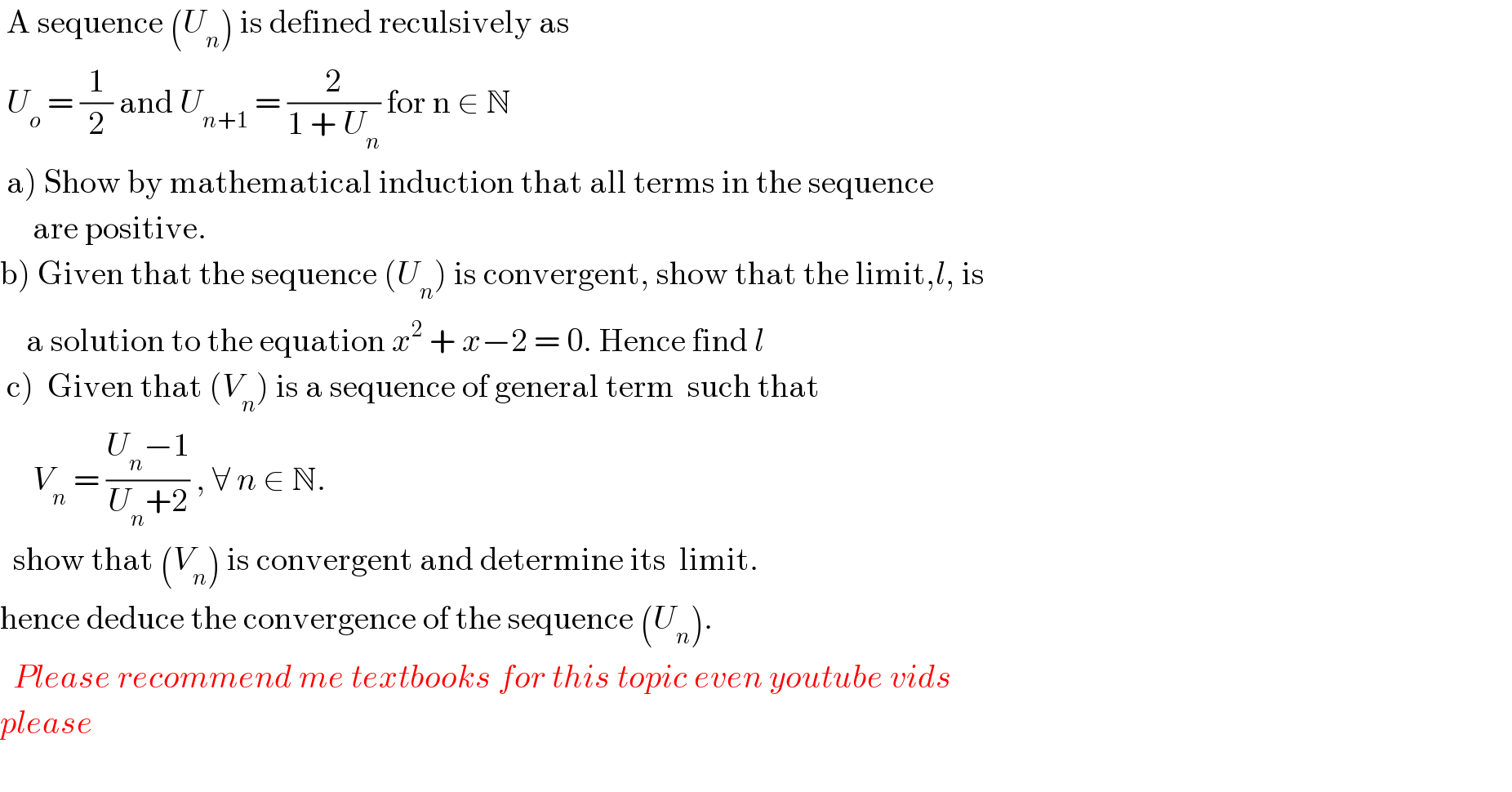
Question Number 87308 by Rio Michael last updated on 03/Apr/20

$$\:\mathrm{A}\:\mathrm{sequence}\:\left({U}_{{n}} \right)\:\mathrm{is}\:\mathrm{defined}\:\mathrm{reculsively}\:\mathrm{as}\: \\ $$$$\:{U}_{{o}} \:=\:\frac{\mathrm{1}}{\mathrm{2}}\:\mathrm{and}\:{U}_{{n}+\mathrm{1}} \:=\:\frac{\mathrm{2}}{\mathrm{1}\:+\:{U}_{{n}} }\:\mathrm{for}\:\mathrm{n}\:\in\:\mathbb{N} \\ $$$$\left.\:\mathrm{a}\right)\:\mathrm{Show}\:\mathrm{by}\:\mathrm{mathematical}\:\mathrm{induction}\:\mathrm{that}\:\mathrm{all}\:\mathrm{terms}\:\mathrm{in}\:\mathrm{the}\:\mathrm{sequence} \\ $$$$\:\:\:\:\:\mathrm{are}\:\mathrm{positive}. \\ $$$$\left.\mathrm{b}\right)\:\mathrm{Given}\:\mathrm{that}\:\mathrm{the}\:\mathrm{sequence}\:\left({U}_{{n}} \right)\:\mathrm{is}\:\mathrm{convergent},\:\mathrm{show}\:\mathrm{that}\:\mathrm{the}\:\mathrm{limit},{l},\:\mathrm{is} \\ $$$$\:\:\:\:\mathrm{a}\:\mathrm{solution}\:\mathrm{to}\:\mathrm{the}\:\mathrm{equation}\:{x}^{\mathrm{2}} \:+\:{x}−\mathrm{2}\:=\:\mathrm{0}.\:\mathrm{Hence}\:\mathrm{find}\:{l} \\ $$$$\left.\:\mathrm{c}\right)\:\:\mathrm{Given}\:\mathrm{that}\:\left({V}_{{n}} \right)\:\mathrm{is}\:\mathrm{a}\:\mathrm{sequence}\:\mathrm{of}\:\mathrm{general}\:\mathrm{term}\:\:\mathrm{such}\:\mathrm{that}\: \\ $$$$\:\:\:\:\:{V}_{{n}} \:=\:\frac{{U}_{{n}} −\mathrm{1}}{{U}_{{n}} +\mathrm{2}}\:,\:\forall\:{n}\:\in\:\mathbb{N}. \\ $$$$\:\:\mathrm{show}\:\mathrm{that}\:\left({V}_{{n}} \right)\:\mathrm{is}\:\mathrm{convergent}\:\mathrm{and}\:\mathrm{determine}\:\mathrm{its}\:\:\mathrm{limit}. \\ $$$$\mathrm{hence}\:\mathrm{deduce}\:\mathrm{the}\:\mathrm{convergence}\:\mathrm{of}\:\mathrm{the}\:\mathrm{sequence}\:\left({U}_{{n}} \right). \\ $$$$\:\:{Please}\:{recommend}\:{me}\:{textbooks}\:{for}\:{this}\:{topic}\:{even}\:{youtube}\:{vids} \\ $$$${please} \\ $$$$ \\ $$
